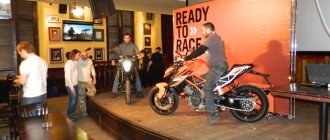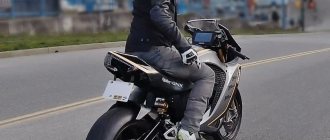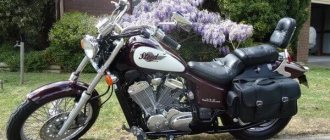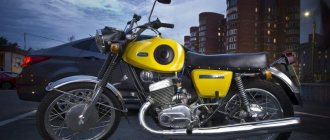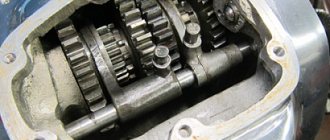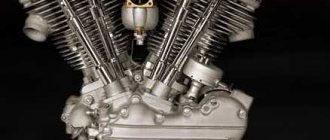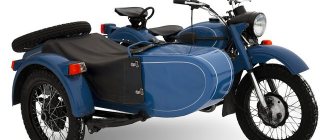For many Russian motorcyclists, the first bike is the Ural M 67 36 - Soviet industry produced hundreds of thousands of copies in the 70-80s of the last century, and many of them are still alive. Affordable price, reputation as a “tough motorcycle for real men” and phenomenal maintainability made this bike incredibly popular.
Specifications
In the Urals, the technical characteristics depend on the specific model, of which there were many. Being, according to the official classification, a heavy motorcycle, this model was equipped with a side trailer and had a solid length of the frame and chassis as a whole.
Engine
On early models, the engine capacity of the Ural motorcycle reached 750 cubic meters. cm, but on the M67 it was reduced to 650cc . Power is 36 horsepower on later versions and 32 on early versions . boxer motor weighs a lot, and dismantling it requires considerable force, so this operation is definitely not possible to cope with alone.
Transmission
All Urals were equipped with a 4-speed gearbox with reverse gear , which was activated by a separate lever. The mediocre reliability of the gearbox led to the fact that many owners replaced it with one from the Dnepr, which was distinguished by a less reliable engine, prone to cranking of the liners, but at the same time a less problematic transmission.
Chassis and brakes
The recipe for the Soviet monster is simple - more iron! A steel frame , spoked tube wheels, toothy tires for dirt roads, a primitive but extremely reliable suspension - this is a completely comprehensive characteristic of the Ural chassis. The brakes were mechanical, drum , so their efficiency cannot be called high. There is no fuss with spring-oil shock absorbers either; even without maintenance, they can feel great for years.
Electronics
There are a minimum of wires in the Urals; 12-volt battery is used . It is worth immediately replacing the armored wires and spark plug caps with better ones, since the caps, exposed to bad weather, heat up from the cylinders, and after driving through a puddle they cool down sharply and therefore often crack. Rubber models instead of plastic ones have proven themselves well.
Weight and dimensions
The weight of the Ural motorcycle without a sidecar is about 220 kg , and a hundred kilograms more with it. By modern standards, its mass cannot be called large; many cruisers weigh one and a half times more. And it’s worth remembering that, due to the presence of a side trailer, the Ural is comparable in width to a small car, so you can’t fit it between the rows.
Controllability
The Ural M 67 with a side trailer is extremely difficult , and it is not recommended . When turning, you need to slow down, as a three-wheeled motorcycle has a tendency to tip over. And without a side trailer, it can reach speeds of up to 110 km/h , and in this case it is much easier to control.
Fuel consumption
The refueling volumes on all modifications of the Urals are almost the same, the M67 was no exception. The tank capacity is 19 liters , which provides about 200 km of travel without refueling .
The engine was originally designed for AI-76, so you can safely fill it with the cheapest gasoline.
Disadvantages of the IMZ-8.103-10 (IMZ-8.103-30, M-67-36) engine of the Ural motorcycle
- Small resource;
- Starting is difficult or does not start at all;
- In hot weather, it gets very hot in low gears;
- Interruptions in the operation of the cylinders;
- Knocking;
- High fuel consumption;
- There are a sufficient number of cases of inaccuracy in the manufacture of the engine crankcase at the cylinder mounting points;
- It is difficult to select timing gears to replace worn ones;
- Oil is leaking at the joints.
More details about the disadvantages...
Unlike engines of analogue imported motorcycles, the service life of the IMZ-8.103-10 engine before repair is small, from 20 to 45 thousand km, which is explained by increased wear of the crank and piston group parts. Increased wear is a consequence of insufficient air cooling, as well as not very good quality of parts (material, manufacturing accuracy).
Difficulty starting or won't start at all
For the most part, starting the IMZ-8.103-10 engine is difficult when the ignition, fuel supply and clearances in the valves of the gas distribution mechanism (between the rods and rocker arms) are not adjusted. The reason may be reduced compression in the cylinders, clogged carburetor jets, water in the carburetors, spark plugs not working, a failed condenser, a lean mixture of fuel coming from the carburetors (too much fuel).
In hot weather it gets very hot in low gears
Unfortunately, air cooling has a detrimental effect on the engine when operating in hot weather. Therefore, in hot weather, when driving in lower gears, overheating should not be allowed, so it is necessary to stop more often to cool the engine. If the engine is new, it can easily overheat.
To a greater extent, interruptions in the operation of the cylinders are caused by the lack of synchronous operation of the cylinders due to different amounts of the supplied combustible mixture, and by a violation in the adjustment of the valves.
The cause of engine knocking may be: pre-ignition; overheat; wear of pistons, rings, fingers; wear of the crankshaft main bearings; valve adjustment is incorrect.
Carburetors are simple and uneconomical, the consumption even according to the instruction manual is like that of a Zhiguli, but in reality it is even higher. During the Soviet era, they didn’t think about efficiency, and drivers poured gasoline into the ground; there was nowhere to put it. These fuel costs are too high for a motorcycle these days.
There are a sufficient number of cases of inaccuracy in the manufacture of the engine crankcase at the cylinder mounting points
This leads to overheating of the cylinder due to the difference in size until the upper plane of the pistons at top dead center aligns with the upper edge of the cylinders. In the event that one of the cylinders overheats and there is no cure for this, as an option it is necessary to check whether the piston at its highest point reaches the upper plane of the cylinder; if not, then this is the problem. To eliminate overheating, it is necessary to achieve symmetrical dimensions, for which purpose the gaskets are removed from under one of the cylinders, and in its place a heat-resistant sealant is used when installing the cylinder. It is possible to install a thinner gasket.
It is difficult to find timing gears to replace worn ones
This problem is associated with the difficulty of finding a set of gears (gears) corresponding to the size group of the crankcase with the dimensional indices. There are a lot of these gears on sale, but there are no markings (indices) on them, or there is a designation, but it is not suitable. You can read about the correspondence of gear indexes and crankcase size groups here.
Repair and tuning
Close to 100% maintainability and huge scope for tuning are the strengths of the Urals . But all this will require a garage, a lot of tools and even more free time.
Repair
The Ural motorcycle requires attention often, and breakdowns happen from time to time. To avoid them, the bike needs to be given the closest attention, often servicing the cardan, adjusting valve clearances, setting the ignition correctly and performing other service operations.
Spare parts
They are available and inexpensive, but the quality varies from acceptable to extremely poor. The mediocre quality of spare parts is one of the reasons for frequently occurring problems.
Tuning
It is the old Urals that most often act as donors for novice customizers due to their low cost. They make a lot of things out of them, from trikes and custom choppers to scramblers and even sportbikes . The results sometimes smack of rural charm, but there are also some very worthy customs.
Chassis
The M62 is equipped with a telescopic fork with hydraulic shock absorbers and internal springs. The difference between this fork and the M72 fork is a different spring arrangement and a slightly different design of the fork leg shock absorber.
Each shock absorber consists of a housing, a rod 11 with a piston 17, a lower guide and a housing nut. The shock absorber body is placed inside the fork leg tube. Holes for oil passage are drilled in the lower part of the housing.
The piston has a disc-shaped shape. The edges of the piston fit tightly to the inner surface of the shock absorber body.
The shock absorber tube nut is a cup with a calibrated hole in the center. A rubber buffer is installed inside the nut to protect the piston from sudden impacts.
The shock absorber body moves along with the tips of the fork stays, and the rod and the lower guide rod with the piston are stationary
A fork spring is screwed onto the spiral groove of the shock absorber body nut, the upper end of which is screwed onto the spring tip mounted on the rod and clamped between two nuts.
When assembling the front fork, you must ensure that there is a gap of 0.2-0.5 mm between the upper tip of the spring and the nut locking the tightening nut of the fork leg tube, ensuring free rotation of the tightening nut with the rod.
M 62 front fork diagram
The rear suspension of the chassis consists of two identical units, does not have hydraulic shock absorbers and is installed in the rear frame brackets.
Motorcycle modifications
The original M67 was produced until 1984, and only in the configuration with a side trailer, but without third wheel drive. It was replaced by modification 8.103.30, which has much in common with it. And since the 90s, the production of completely different Urals began - “Solo”, “Voyage”, “Wolf” and others. Currently, the Ural plant in Irbit produces completely different models that have little in common with the old Urals.
masses of units
masses of units
Post by Nitro » Mon Apr 21, 2008 7:05 pm
There is no data on radiators. Accordingly, most of the data is not available, but you can estimate
Power unit 2101 117 kg Lubrication system 2101 3.75 l Cooling system 2101 9.9 l
Power unit 2108 82 kg Lubrication system 2108 3.5 l Cooling system 2108 7.8 l
Power unit 331.7 128 kg Lubrication system 331.7 4.8 l Radiator 2141 5.5 kg Cooling system 2141 9 l
Power unit 1111 66.5 kg Lubrication system 1111 2.5 l Cooling system 1111 4.8 l
KP 2101 26 kg Carter KP 2101 1.35 l
KP 2108 34 kg Carter KP 2108 3.3 l
KP 2141 40 kg Carter KP 2141 3.4 l
KP 1111 24.5 kg Carter KP 1111 1.8 l
Rear hub 2108 assembled 2.5 kg Brake disc 2108 4 kg Knuckle 2108 4.5 kg Caliper 2108 3 kg
Rear hub 2141 assembled? kg Brake disc 2141 4.2 kg Knuckle 2141 5 kg Caliper 2141 ? kg
Front suspension 2101 assembled? kg Front suspension 2108 assembled 55 kg Front suspension 2121 assembled? kg Front suspension assembly 2141 72.5 kg Front suspension assembly 2410 ? kg OKA stand assembly 14.2 kg
CV joint 2141 standard 6 kg
Gas tank 2101 39.0 l = 28.7 kg Gas tank 2104 45.0 l = 33.1 kg Gas tank 2108 43.0 l = 31.6 kg
Wheel 2108 beskam 13.4 kg Wheel 2410 21 kg
Post by zilbergilzen » Mon Apr 21, 2008 9:57 pm
Post by wat » Tue Apr 22, 2008 1:43 am
Posted by Nitro » Tue Apr 22, 2008 9:12 am
Post by zilbergilzen » Tue Apr 22, 2008 6:40 pm
Weight of units (in kg): Engine assembly - 114; gearbox with clutch housing - 32; transfer case - 27.6, rear axle - 60.5, front axle with front wheel drive - 32; complete body without upholstery - 284; wheel with tire - 21.
Post by ForSash » Tue Nov 18, 2008 10:14 am
Maybe it will help someone (don’t take it as advertising, please - this is serious work that has been going on for more than one year)
Historically, we supply components for various pneumatic manufacturers. First of all - for “Litvina”, as well as for “Trekol”. So, this is not the first year we have been collecting information on the weight of spare parts. They themselves hung about 20 thousand pieces of iron in warehouses. About 30 thousand more were found from other sources.
We don’t yet keep it in the public domain in the form of a complete reference book, but you can look at the characteristics of individual parts. In particular, here on the website https://www.avtoall.ru, in our product cards, the weight is marked for the spare part, if it is known to us. (don't take it as an advertisement)
Post by ilmar » Tue Nov 18, 2008 1:27 pm
Posted by ACD » Tue Nov 18, 2008 1:54 pm
Post by ilmar » Tue Nov 18, 2008 2:36 pm
Post by ForSash » Tue Nov 18, 2008 3:28 pm
I am interested in this weight as an average statistical parameter. For example, if an SPZ bearing weighs 150 grams, then the same SKF bearing will weigh the same, because I will simply copy the weight from one to the other. Therefore, I cannot say that each figure given is 100 percent verified. For example, a reference book on weights of spare parts from the ZIL plant was given to me as a terrible military secret, and only after 135 requests. And you can’t keep track of the number of typos that manufacturers come across, even though we try and hang the hardware in warehouses ourselves. Again, there is the question of the weight of the packaging container, the density of liquids, and completeness. Well, in general, there are a lot of subtleties in this seemingly simple matter.
Therefore, it somehow doesn’t even occur to me to post such data in the form of a DIRECTORY. This is sewn into the internal database, rather as a GUIDELINE by which you can estimate whether the weight of the cargo will fit into a 3-ton container or whether you need to order a 5-ton container. Well, something like this, in general.
Source
Advantages and disadvantages
The strengths and weaknesses of the model are obvious, and they are inextricably interrelated. The archaic and outdated design half a century ago is unreliable, but thanks to its simplicity bordering on primitivism, it is easy to maintain and repair.
Advantages
- Quite high power compared to most other Soviet motorcycles.
- Huge scope for tuning . What craftsmen don’t install on Urals, from the injector to the fifth gear!
- Total maintainability . The bike can be repaired no matter what happens to it. Always.
- Undemanding to the quality of gasoline.
- Short service intervals . Valves require frequent adjustment.
Flaws
- The deplorable technical condition of most copies.
- Low quality components , which leads to frequent minor breakdowns.
- High fuel consumption .
Malfunctions
One of the features of the power units of Ural motorcycles is the relatively frequent occurrence of minor faults, which must be eliminated quite quickly. Delaying repairs can, and usually does, lead to more serious damage and a significant increase in the cost of repairing them. The main malfunctions and the reasons for their occurrence are summarized in the table.
| FAULT | REASON FOR APPEARANCE |
| The motor does not start. | 1. The fuel supply system is clogged. |
| 2. The spark plugs are out of order (carbon deposits, etc.). | |
| 3. Insufficient compression in the cylinders (valve clearances, rings, etc.). | |
| The power unit operates intermittently. | 1. Uneven fuel supply. |
| 2. Water in the engine or fuel. | |
| 3. The injector jets or nozzles are clogged. | |
| 4. Spark plugs are faulty. | |
| 5. The integrity of the electrical wiring is broken. | |
| 6. Excessively enriched fuel-air mixture. | |
| Extraneous knocking noise in the engine. | 1. Early ignition is set. |
| 2. Motor overheating. | |
| 3. Problems with pistons and rings (loose fit, etc.). |
Owner reviews
A powerful unit with decent performance characteristics, in the right hands can live forever, or as long as there are spare parts. Considering how many opposition pieces were riveted in the USSR, there is every chance of passing it on to one’s grandchildren as an inheritance. Anyone who says that this is a bad spender simply does not know how to handle it. Igor, Smolensk.
I started my two-wheeled life with a stroller, like many, and rode until I earned money for an old Honda Steed. When I sold the stroller and switched to a Japanese one, I drove it once and realized that when I go to hell, part of the torment will be credited to me there))) Ivan, Tver.
In stock condition, it’s trash, killed by a disregard for it. With the right approach, the motorcycle is reliable and durable, it will go anywhere, there are enough horses and torque, it can be repaired with a hammer and a screwdriver, and it will eat any gasoline. If you put survivability at the forefront, then Uralei has no competitors except old Harleys, but here the price of the issue is completely different. Anton, Murom.
History of the Ural model
First, it is worth recalling that the first all-wheel drive motorcycles appeared in England about 100 years ago. For a long time they had no competitors in terms of price-quality ratio. Subsequently, BMW began production of a military modification of such equipment.
It is believed that military all-wheel drive options made such motorcycles very popular. At least in our country, after the Great Patriotic War, the production of German military “clones” began.
Over time, through modifications and improvements, the domestic market received excellent, reliable and practical equipment for various purposes. They were used by the police and various inspections; they were highly valued by the villagers. At that time, cars were in short supply, so the Ural motorcycle was an excellent alternative to scarce vehicles.
The troops were equipped with machine guns and anti-tank installations. It was a very effective weapon. But over time, under pressure from the development of military technology, they were abandoned. Since then, the Ural model range has expanded greatly.
FAQ
- How much does a Ural motorcycle weigh without a sidecar? Not much - about 220 kg. But many owners dismantle the cradle permanently, removing some components and thereby making the bike lighter.
- How many cubes are there in a Ural motorcycle? In older models - 650. In modern ones - 750.
- How much does a Ural motorcycle with sidecar weigh? Weight varies depending on the specific modification, but on average it is about 320 kg.
- Is it comfortable to drive around the city? Not very much, given the solid overall dimensions.
- How much does he really eat? A bike without a sidecar consumes about 6 liters when riding leisurely on the road. But if you drive aggressively, the consumption will be higher, up to 8 liters or more.
Singles
Name Characteristics Type Diesel, turbocharged diesel Volume 11 liters 11,150 cm3 Configuration, parameter V-shaped Number of cylinders 6 Number of valves 12 Econorm Euro 3 Euro 4 YaMZ-6566 Euro 5 YaMZ-6567 Engine power, l. The new piston skirts are coated with Teflon to reduce friction, the seating precision of the new high-tech rings has been improved, and several space-age coatings have been applied, such as plasma-sprayed molybdenum alloy and manganese phosphate on the rings.
Conclusion
Many bikers started out as boxer road veterans found in grandpa's garage. Ural M 67 is an excellent learning desk that will teach you not only how to ride, but also how to maintain a motorcycle, and of course, how to repair it. And after this fiend of the Soviet motorcycle industry, you will be able to handle any other bike! This is the case when starting with a structurally simple motorcycle would be a good idea, especially since a fair number of them can always be found on the secondary market, and for very modest money.
Specifications
| Maximum engine power: | 36 HP |
| Working volume: | 649 cm3 |
| Motor type (cylinder arrangement, number of strokes): | Opposed |
| Number of cylinders: | 2 |
| Number of valves: | |
| Intake type (Injector / Carburetor): | |
| Bore and stroke: | |
| Starting system (Electric starter, kick starter): | |
| Maximum speed in km/h: | 105 km/h |
| Cooling system: | Air cooling |
| Transmission (gearbox): | 4-speed, manual |
| Clutch (Dry / Wet): | |
| Drive unit: | Cardan |
| Frame: | Steel tubular |
| Chassis | |
| Suspension (front/rear travel): | |
| Brakes (Front/Rear): | |
| Wheels / Tires / Rubber: | |
| Dimensions and weight | |
| Dimensions (Length / Width): | |
| Seat height: | |
| Ground clearance: | |
| Curb weight: | |
| Weight: | 330 with stroller kg |
| Fuel tank capacity: | 19 l. |
| Battery capacity: | |
| Year of release: | |
| Country of Origin: |
Transmission
Until 1963, the K 750 was equipped with an M-72 motorcycle gearbox. Later, changes were made to the design of the shift clutches, the secondary shaft and its gears.
Splines are cut on the secondary shaft, along the outer diameter of which the gears can rotate freely.
Between the gears of the first and second gears, as well as the third and fourth gears, fixed bushings are installed on the splines of the secondary shaft. These bushings also have external splines along which the movable couplings move. The internal surfaces of the couplings have small splines for engagement with the splines of the gears of the corresponding gears.
How to check the foot switch mechanism
The need to adjust the foot shift mechanism may be necessary after the transmission has been rebuilt or if the locknuts have become loose. To do this, move the motorcycle manually and change gears from 2nd to 3rd and vice versa. It is necessary to achieve easy switching. The motorcycle is also placed on a stand, the rear wheel is hung out and the engine is started. When switching from third to second speed, you need to press on the front shoulder of the pedal. Looking to the left, the pedal should turn counterclockwise and the pawl crank clockwise and will therefore rest against the top stop. It needs to be adjusted.
